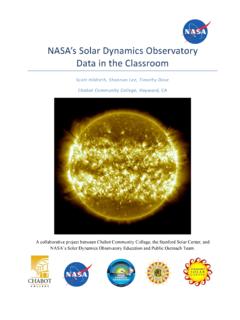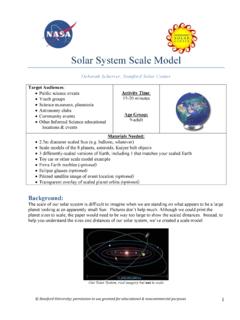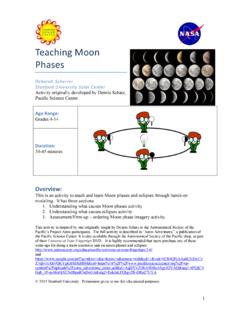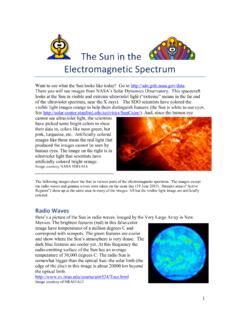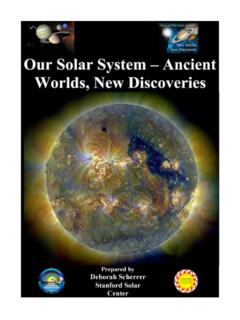Transcription of Solstice and Equinox (“Suntrack”) Season Model
1 Stanford University; permission to use granted for educational & noncommercial purposes 1 Solstice and Equinox ( suntrack ) Season Model Philip S cherrer & De borah S cherrer, Stanford Solar Center Introduction This physical Model simulates the Sun s tracks across the sky at summer Solstice (longest track), winter Solstice (shortest track), and the spring and fall equinoxes (medium track). A bead simulates the Sun moving from rising along the eastern horizon to setting on the western. The bead can be moved from track to track to demonstrate the solstices and equinoxes.
2 The Model is made to accurately represent the user s latitude. Many people are confused about the meaning of solstices and equinoxes. Verbal descriptions are often inadequate because they are difficult to envision or overly technical. Imagery is helpful, but some have trouble understanding the perspective of the imagery. This physical Model was developed (over years) to enhance the teaching of the Solstice and Equinox concepts, as well as being helpful in understanding solar alignments of cultural and archaeoastronomy sites.
3 A quote from Cidney Webster, National Park Service: My program was a guided walk through the park and the topic was the winter Solstice .. I copied a diorama used by Dr. and Mrs. Scherrer during the training that demonstrated the Sun's position in the sky at different times of the year. This became my most effective teaching tool. Everyone loved the diorama!" Includes instructions for a simple, low-cost version made from paper plates and pipe cleaners. Sun Track Model 2 Target Audiences: Youth and after school groups National and state park leaders Middle school and upper elementary science teachers For display at public science events Science museums, planetariums Astronomy clubs Community events Construction Time: ~2+ hours (not including decoration) Age Group: Can be used by 8 adult For construction, an adult is needed Materials Needed for complex Model .
4 30 cm (12 inch) diameter particleboard disk, 2 cm ( inch) thick -- purchased (often available precut at places like Home Depot ) Plastic cord such as used in Weed Whacker machines, to be used as Sun tracks Large bead to use as Sun; needs to fit on the plastic cord; white is preferred since the Sun is white. Electric drill and bit for drilling holes to insert Sun tracks Materials for decoration (optional) Materials for the simple Model are given below Learner Objectives: That the Sun in Earth s sky has regular and predictable motions.
5 These motions explain such phenomena as the seasons, equinoxes, and solstices. Because of the Earth s tilt and its orbit around the Sun, the Sun appears to rise and set in a slightly different direction each day. A Solstice is an astronomical event that occurs twice each year as the Sun reaches its farthest north or south rising and setting points on the horizon. The official astronomical Equinox occurs twice a year, when the plane of the Earth's equator passes the center of the Sun. However, pre-technological cultures have defined the Equinox as the date the Sun rises due east and sets due west of their location.
6 This difference can cause problems for understanding astronomically aligned structures. Understanding Movements of the Sun in the Sky Most people are aware that the Sun rises in the east and sets in the west. Although ancient cultures were acutely aware of the movements of the Sun, Moon, planets, and stars, few modern people understand that the sunrise and sunset locations on the horizon change slightly each day. Nor are many people aware that, except near the equator, the Sun rises on a diagonal (as in the image at right).
7 On summer Solstice , the Sun rises as far northeast as it ever gets, and sets as far northwest as it gets. This results in many hours of daylight, and summer. On the Model , summer Solstice is represented by the longest cord. Sunrise at Equinox at latitude 37 degrees facing due east Sun Track Model 3 Every day from summer Solstice the Sun rises and sets a bit further south. Three months later it rises due east and sets due west, which we call the Equinox . Now, we have roughly equal hours of daylight and nighttime, and it is the start of fall.
8 Your Model shows this as the medium-length cord that runs from due east to due west. The Sun continues it southward march until, on the winter Solstice , it rises as far southeast as it gets and sets as far southwest. The Sun s track is low in the sky and we have fewer hours of daylight than nighttime. It is winter, dark and cold. Your Model shows this as the shortest cord. After the winter Solstice , the Sun starts working its way back up to the northeast and the pattern repeats. Note that, because of the tilt of the Earth, the Sun is never directly overhead, except if one is at a latitude of less than degrees.
9 Solstices: Summer Solstice occurs on the day the Sun has reached its highest/northernmost point in Earth s sky, marking the beginning of summer (in the northern hemisphere). This is around 21 June. Winter Solstice occurs on the day the Sun reaches its lowest/southernmost point in the sky, marking the beginning of winter (in the northern hemisphere). Winter Solstice is around 22 December. For more details, check out Sun Track Model 4 Winter Solstice was of particular interest to many pre-technological cultures.
10 Because the Sun rose and set at a very southern/low point, people were concerned that it might continue its southward journey, hence leaving the Earth in darkness. Ceremonies were held to encourage the Sun to resume its journey northward, or to celebrate the change to longer days. Many Solstice and winter celebrations have descended from these events. Equinoxes: The equinoxes are astronomically defined as either of the two moments in the year when the Sun is exactly above the equator ( when the plane of the Earth's equator passes the center of the Sun).
